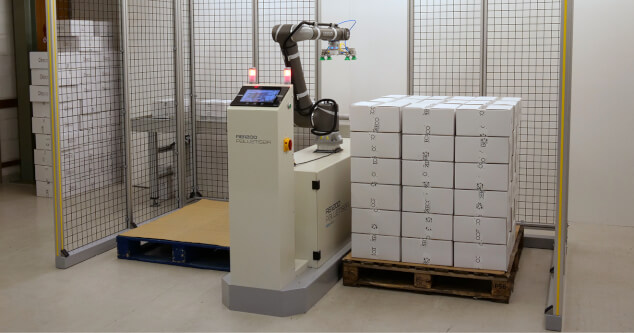The Pitfalls of Manual Handling in End of Line Applications and Why Automation Is The Solution
Published on 18 November, 2021 in Flexible Manufacturing
No matter the industry you operate in, packaging, managing, and getting your inventory to where it needs to be is a significant headache. Businesses require robust and agile palletising processes that maximise efficiency, eliminate costly errors, and integrate seamlessly within wider workflows.
Automating your end of line applications offers a range of tangible business benefits to increase output, reduce costs, and give your company a real competitive advantage.
In the past, implementing new automated systems has been seen as too complex a process. The learning curve of integrating an entirely new system has appeared too steep to reach the benefits on the other end.
But with new collaborative robotic systems, like the RB1200 Cobot Palletiser from Omron, automating your end of line processes has never been simpler. The RB1200 provides versatile and straightforward solutions for your palletising needs. The plug and play system with intuitive visual software can be configured in minutes to match the product and configuration you require.
With advanced automation solutions for end of line applications, your business can simplify stock management and avoid the pitfalls associated with manual handling.
Companies that rely on manual handling to stack and transport their goods are doing business on hard mode, making a complex task more difficult. The downsides of utilising manual handling in your end of line processes include:

Health & Safety
Manually handling goods places a considerable strain on employees. Handling, lifting, carrying and arranging inventory increases the risk of Repetitive Strain Injury (RSI) while also having the potential of severe accidents.
The repetitive motion required to palletise products manually leaves staff susceptible to RSIs. This means more employees develop pain in their muscles, nerves, and tendons that can worsen and produce long-term effects without treatment. Labour Force Survey suggests that there are over 200,000 work-related RSIs in the UK every year.
Even with greater health and safety guidelines, total workplace injuries from handling, lifting, and carrying are rising. The Health and Safety Executive (HSE) estimate 693,000 workers sustained a non-fatal injury in 2019/2020, of which 19% (131,700) were caused by handling, lifting, and carrying. An increase of over 13% from the year before (116,200 injuries).
Workplace injuries are terrible for both employees and employers. They prevent staff from performing the work required, resulting in lost work and revenue and causing significant disruption. Therefore, employers need to develop contingency plans for their occurrence and find ways to manage the workforce to maintain output.

Bottlenecks and Inefficiencies
When it comes to repetitive physical tasks, staff performance is variable. It is hard to find employees who can maintain focus and work at a consistent output while performing these often monotonous jobs.
Manually performing end of line applications like palletising leads to inefficiencies creeping in and bottlenecks that hold companies back from maximising their output. In the worst-case scenarios, it produces costly errors.
It would be great if every process within your company were independent. But in reality, they are all part of a whole and inefficiencies in one area compound by affecting every process that follows. By removing palletising bottlenecks, you can dramatically improve the whole of your inventory management, boosting the overall performance of your operations.
Labour Shortages
With the effects of the pandemic and Brexit, the UK is experiencing severe labour shortages across multiple industries. With fewer employees available, companies are struggling to maintain output and match demand.
The only way to meet this at the moment is to:
- offer better wages, incentivising people to join your company
- find ways of getting more from your existing workforce
Increasing wages affects your bottom line and reduces profit margins. Asking staff to work longer hours can backfire due to burnout, increasing absences and employee turnover.
The remaining solution is increasing productivity by integrating new technologies.
Implementing Automated Palletiser Solutions
Automated solutions are no longer complex endeavours that require a team of engineers for every minor change. Collaborative robotic systems are now available that simplify the palletising process from initial integration to management and redeployment around the facility.
Common barriers preventing new automated solutions include:
- Reduced flexibility
- Upfront expense
- Fear of change
But with palletising systems like the RB1200 Cobot palletiser, you get:
- A versatile solution that can reconfigure to new applications and switch between lines in minutes.
- Reduced upfront costs, up to 50% less than conventional robot palletisers.
Plus, given the downsides of manually handling palletising processes, companies should fear inertia more than change.

Four Headaches the RB1200 Palletiser Can Overcome for Your Business
- Variable Stock Profiles
No matter the inventory you need packaging, the RB1200 can solve your palletiser needs. It can handle products up to 10kg and quickly configure depending on stock profile and pallet dimensions. - Space Constraints
With a compact footprint (2.2 x 3.2m), the RB1200 offers a 60% size reduction compared to traditional palletisers, preserving the floor space available in your facility. No longer any need to stress about transitioning your robotic palletiser system between lines. - Limited Operating Modes
The RB1200 offers maximal utilisation, with the ability to configure its operation for your specific needs. Whatever your product and however you want it packaged and made ready for transport, the flexible RB1200 can be deployed to match. - Complexity of Automation
With new collaborative robotic systems, automation is now accessible to all companies, no matter their size or staff expertise. Plug and play, versatile solutions mean staff can quickly learn to install and configure for different end of line applications. The intuitive visual software requires only a few steps and inputs to implement.
OMRON
The RB1200 cobot palletiser can completely revolutionise your end of line processes. Removing the burden on staff and simplifying workflows to increase the output of your facility.
Visit OMRON or Reeco today to discover the advantages automation can deliver to your company
Contact us for more information